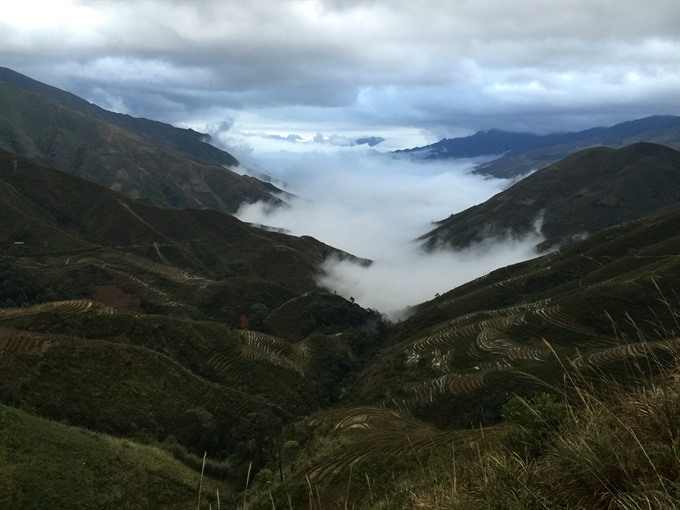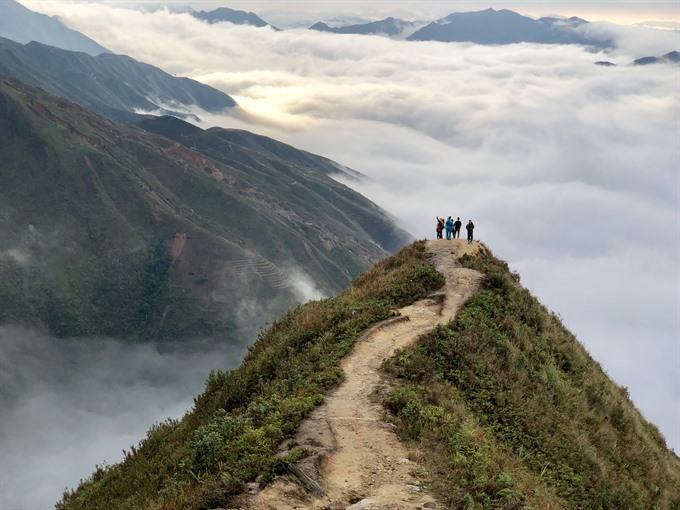Viet Nam News
by Tran Mai Huong
Ta Xua, a high mountain range locating in the natural border between northern provinces of Son La and Yen Bai, has been known as "Paradise in the Clouds", which hosts forests of ancient Shan Tuyet tea trees, some several hundred years old.
The range consists of three peaks - according to the map by the People’s Army, the highest peak is 2,879m, the second is 2800, the lowest named Dinosaur Backbone is 2,582m.
Photographers and backpackers who’ve been to Ta Xua always talk about hunting moving clouds on the dangerous routes.
The mountains covered with clouds create a mysterious beauty, which is more alluring when viewed from Song Khung Long (Dinosaur’s Backbone), which located in Bac Yen District of Son La Province.
The Dinosaur’s Backbone, seems to lie in the middle of the sky.
The path to its peak is dangerous. In some places, there is only one small path with deep abysses on both sides.
When stepping on that path, strong winds can shake travellers’ bodies, forcing them to double over or be blown off.
A sign erected on the top of the peak says: “Ta Xua Paradise of Clouds” - an official acknowledgement of the nickname.
People talk a lot about the beauty of the clouds. If lucky, tourists will see a sea of clouds nestled below them in the centre of the huge mountain range. They often come in all shapes and colours. It’s a fairy land.
Yet getting to this heaven is not simple. We reached Ta Xua on a rainy day. The zig-zag roads were steep, muddy and covered with humid grey clouds.
Pham Vu Khanh, a low-land man, who has settled down in the locality for dozens of years, received us.
He said many people climbed up to Ta Xua, but few were lucky enough to see the legendary "cloud land" appear.
He wished us good luck. That night, Khanh invited us to have Tuyet Shan tea, Hang Chu rice wine and some dishes made from a local species of black pig.
We enjoyed the local delicacies, which kept us warm, but worried a lot because it was raining cats and dogs.
Most of us went to sleep wondering if we would be able to see the magic clouds in the morning.
Before dawn next day, we were awakened. Khanh urged us to get in a car to the Dinosaur Backbone peak without delay.
Because he has lived there for a long time, he senses when and where beautiful clouds will appear. It seems to depend on the seasons and time of day.
It was still raining, but much less than before. Khanh was correct. White clouds were flying up from the valleys. We had to reach Dinosaur Backbone as soon as possible to catch the beautiful images.
 |
| Lake of clouds: Standing on top of Dinosaur Backbone Peak, one can see terraced fields and a valley filled with clouds. VNS Photo Tran Mai Huong |
Three kilometres from the peak, our car could go no further as there was a landslide. We all continued by catching motorbike taxis servicing the remote area. My driver was fairly agile. He was only 16.
He took visitors on his bike to the landslide to make extra money for his vocational training. Without him, we would have had to walk and missed our chance of seeing the wonderful clouds.
The last trek was only 2km, but extremely hard. From a distance, the path curving along the side of the mountain looked fairly romantic, but we slipped and fell when we took our first steps.
We had to overcome high slippery slopes in the rain. We pushed forward, pressing down with our toes on the path as there was nothing to hold on. We were lucky to reach Dinosaur Backbone peak together with many other young people hunting for clouds.
Then the sun started to shine. From the furthest edge of Dinosaur Backbone, we could see clouds hanging here and there.
The feeling of travelling on top of clouds, above the clouds, flying between land and sky was so special.
We took great photos of clouds of unforgettable scenes before it rained again.
Everything was then submerged in a huge grey blanket of fog. We returned to the small path with abysses on both sides.
The wind blew strong as if it would lift us off. What an experience!
 |
| Stunning: Dinosaur Backbone seems to lie in the middle of the sky. VNS Photo Tran Mai Huong |
Ta Xua is located in the middle of Bac Yen, a mountain district with advantages in economy and culture, and home to seven ethnic groups.
Famous novel Mien Tay Dac Sac by To Hoai reflects the life and people in the area.
Hong Ngai Commune, just next to Ta Xua, was the homeland of the A Phu couple, the main characters in the novel.
Just few week before we arrived, Ta Xua hosted a cultural festival enjoyed by hundreds of locals and tourists, who sang, played folk games, and cooked traditional food.
At the event, local authorities announced a decision by the National Office of Intellectual Property to recognise Ta Xua Tea trademark as a local delicacy.
Forests of Shan Tuyet tea trees, hundreds of years old, are a special feature of the area.
Big tea trees with broad branches grow on high mountains covered with clouds all year round. They seem to absorb the essence of sunlight and wind into their leaves.
The tea leaves, after being dried, should be infused with boiling water taken from a fresh stream.
The tea is a yellow colour, like honey, and tastes bitter and salty, but with plenty of flavour on the tip of the tongue. People cannot forget the tea even after one sip.